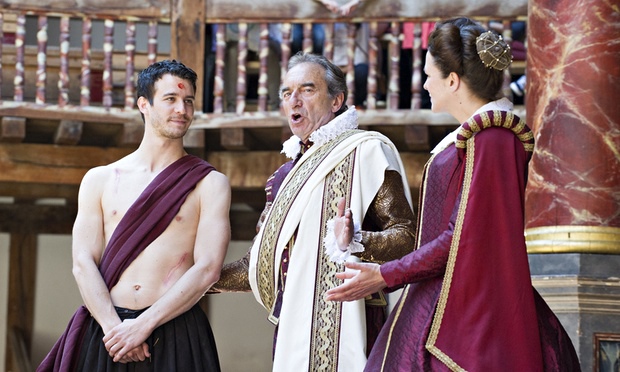Shakespeare’s reconstructed Globe Theatre in London, England,
has been a foreign dream for me. When given a chance to attend a real play at
the Globe, I anticipated seeing a live theatrical performance, with amazing
sets and props, and of course, I anticipated seeing and experiencing
Shakespeare’s timeless works, viewing them as similarly as someone might have
in his day. My anticipations and hopes, to say the least, were let down as the Globe’s
version of Julius Caesar on August 4, 2014, failed to inspire, entertain, or
educate.
My friend and I approached the Globe, with its barn-like
appearance, eager and excited to view director Dominic Dromgoole’s version of Julius
Caesar. I purchased a “standing” ticket, as this was the cheapest option,
but also would provide a unique experience since this was a significant way
theater was done in Shakespeare’s days.
As we waited for the performance to begin, on the floor
level, people stood, surrounding the perimeter of the stage. This concept of
having a hemisphere as a stage rather than just a straight-line, as typically
expected in most theater houses, allows for actors to occupy the whole stage
and to utilize space in unique and beautiful ways. In fact, I have seen some of
Shakespeare’s greatest works come to life at the Old Globe in San Diego. Carrying
these expectations in mind, perhaps, made the experience at the original Globe
unable to live up to my preconceived hopes.
When the play first started, I was excited! I enjoyed the
setting of live music, food and beers all around in the audience members' hands, and actors in costume, walking about, and setting up props. It was so
natural. Then, the play began. As the actors began to engage in their work, the
crowd hushed and all eyes turned towards the expanding stage. As the opening
scene unraveled, actors were sprawled throughout the stage, even standing
amongst the audience, engaging both with the actors on stage, but also the
audience members. This atmosphere created a unique experience for all involved.
The openness of the stage gives freedom to perform in this way and was
something that was done well.
While the stage space was spread out and constantly
evolving, the sets pieces were relatively bland. The stage was set with roman columns
on the balcony and offered wreaths that hung from the ceiling which would
alternate heights, assumedly, depending upon which house the actors were in. Stagehands
and actors themselves brought out props such as chairs and tables. The props
were not ornate or large or bulky since they needed to be easy to move, but, at
times, the props simply did not add to the value of the performance. I often
forgot they were there. While the actors utilized their space well, the props
were downplayed and bland.

These previous elements of stage usage, and sets, props and
costumes, failed to impress. One third factor that drew some appeal was the
notion that when purchasing a standing ticket, anyone is able to live and
experience the lines of Shakespeare as any peasant would have in Shakespeare’s
days. This excited me and even though standing for nearly three hours was not
my idea of fun, I wanted to see what the appeal and draw of this might have
been for Shakespeare’s audience members. After standing and leaning for nearly
three hours, I am not sure what the appeal was. I suppose it was more necessity
than appeal. I am relatively tall, but there was another audience member who
stood directly in front of me for most of the performance. Even after she moved
and I found personal space again, there were some elements of the play that I
could not see because of the many heads in front of me. I gave up trying to see
over their heads, and attempted to imagine what was going on from what the
actors were saying. This worked well enough, but was not ideal. During the
performance, I couldn’t help but reflect on my experiences at the Old Globe in
San Diego. I was able to sit and see dynamic and dimensional stages there. Even
though it was a unique experience to stand for the duration of the play and to
see what audience members may have experienced during the 1500’s, I realized
that, for me, I would much rather enjoy a twenty-first century performance experience.
Overall, while the stage was utilized well, and the actors
performed well enough, it was uninspiring due to the bland props and set
pieces. The costumes were not entertaining as they were odd and not helpful in
creating the right atmosphere. Finally, I realized that I am accustomed to a
different theater experience and I prefer being inspired, entertained, and
learning from the actors and directors’ talents and choices. This performance
was by far the least inspiring Shakespeare performance I have seen and I am
disappointed it was at the Globe in England.
However, if I ever return to England, I will give the Globe
a second chance.
Commentary

No comments:
Post a Comment